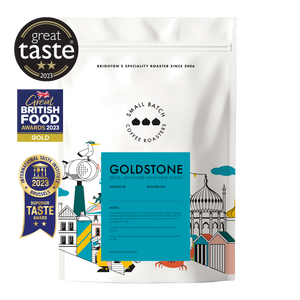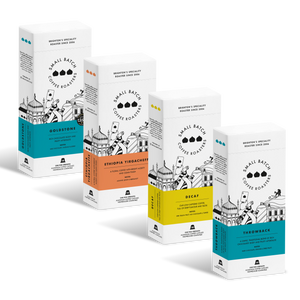Robusta vs Arabica - What’s the Difference?
Aug 13, 2025
A major discussion that comes up time and time again in the coffee industry and with our customers is whether robusta or arabica is superior to the other. In the speciality space, arabica is strongly favoured for its nuanced flavours whilst robusta’s higher caffeine levels and stronger flavour lends itself more to instant coffee.
Here at Small Batch, we source arabica beans from around the world and only use the best quality beans from the best farmers who can guarantee traceability and champion our great taste promise. Sourcing arabica beans means that Small Batch customers are guaranteed high-quality, high-grade flavour with every cup.
But does that necessarily mean one is better than the other? With the coffee industry having to adapt rapidly to climate change and soaring costs, farmers and roasteries alike will have to navigate a blended approach to keep consumers satisfied with both flavour and price.
So what are the key characteristics of both arabica and robusta, and how do the differences affect your cup of coffee?
Arabica
Arabica is the most widely produced type of coffee bean, accounting for 70% of market production. Arabica originates from Ethiopia, with reports stating production as early as the 12th century. The main varieties of arabica coffee are typica and bourbon, with sub-varieties including Java, Jamaica Blue Mountain and Red, Yellow and Pink Bourbon.
These arabica beans are appreciated and favoured more than robusta due to their high-quality nuanced and aromatic flavours, however better taste comes with less caffeine - arabica beans contain between 1.5%-2.7% of caffeine per bean, but has 2x the amount of sugars and lipids to produce more oils for sweeter coffee flavour extraction.
Arabica is a much more expensive bean, both due to demand and also growth production - arabica plants can grow up to 15ft but are pruned to 6ft to keep them viable, as they are more likely to suffer from disease and environmental damage than robusta. However, arabica crops can self pollinate as the plants contain 2 sets of chromosomes, reducing the risk of cross pollination to ensure high-quality fruit and beans year after year.
Overall, arabica is much more prestigious in the speciality community (and for anyone who really values a good tasting coffee) due to the nuanced and consistent flavours, but is more at risk as a plant to disease and extreme weather due to it needing specific growth conditions.
Robusta
Robusta originates from the canephore plant, thriving well in shade and accounting for 30% of the world’s coffee production. Robusta is easily distinguishable due to its rounder shape, whereas arabica is more oval.
Robusta typically has a strong, harsh deep flavour with earthy notes, with a higher caffeine content of 2.7% minimum per bean that makes it suitable for instant coffee. This is where robusta gets a bad rap, often viewed as a cheaper, basic coffee - and if you’re into speciality coffee, then that is true: the beans don’t offer as wide variety of flavour, lack sweetness, and can taste a bit bland which means you typically need sugars or syrups to add some ‘zing’. Why rely on syrups when you can harvest a high quality bean that self-contains that nuance for you?
In a world where costs are rising, cheap may not necessarily be a bad thing, especially if it comes with some environmental benefits. Robusta plants are a lot hardier and resistant to disease and extreme weather, are easier to cultivate and grow in different environments, and are less likely to be affected by insects, as the higher caffeine levels are toxic to bugs.
As demand grows, the industry needs to find new ways to increase production - opening robusta farms in areas that typically cannot grow arabica will thrive financially will help create socioeconomic success, plus it reduces the pressure on arabica farms if crops fail from heat, frost or drought. In the future, we may see coffees that blend arabica and robusta together, developing new methods to reduce the harshness of robusta whilst being more selective with arabica to create a sustainable balance between profits, consumer demand and coffee availability.
Overall, robusta is a great option for those who like a darker, depth of flavour and want a higher caffeine kick. However, it will always falter for the lack of flavour and taste in your cup, which may need to be supplemented. The benefits of robusta when it comes to future farming cannot be ignored however, as its resistance to disease and crop failure may be part of the answer for the rapidly growing demand in the coffee industry from customers.



